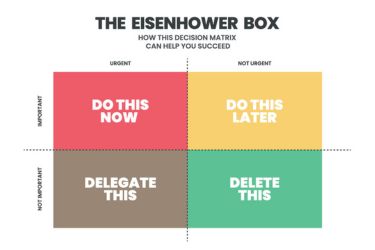Most of us have goals, but achieving them isn’t always easy. “Begin With the End in Mind” teaches us to start with a clear vision of where we want to go before we make a plan to get there. This habit, created by Stephen Covey, helps us focus our actions so that each step moves us towards our biggest goals.

By picturing our lives and successes in advance, we can use our imagination to guide our decisions. When we know our destination, it is easier to make choices that match our values and priorities. Thinking with the end in mind connects what we do today to what we want for our future.
Key Takeaways
- Habit 2 helps us plan by knowing our end goals.
- Imagination helps create a strong personal vision.
- Every choice should connect to our bigger life aims.
Understanding 'Begin With the End in Mind'

'Begin With the End in Mind' encourages us to start each task or project with a clear purpose in mind. By doing this, we align our daily actions with our long-term goals and core values.
Definition and Principles
‘Begin With the End in Mind’ is the second habit in Stephen Covey’s Seven Habits framework. This concept means we should have a clear picture of our desired outcome before we begin any task, project, or major decision. We visualise what success looks like and plan steps accordingly.
Covey explains that all things are created twice: first in our minds as an idea or vision, and then physically through actions. This principle helps us become more purposeful with our choices. We make conscious decisions rather than simply reacting to events.
We can use personal mission statements, goal setting, or envisioning exercises to practise this habit. These tools help us clarify what truly matters to us and keep us on track.
Origins within the Seven Habits
Habit 2 sits at the core of Covey’s Seven Habits of Highly Effective People. The seven habits outline a step-by-step approach for personal and professional growth. ‘Begin With the End in Mind’ follows Habit 1: Be Proactive.
Covey introduced this habit to move us from just taking charge of our actions, to ensuring our actions serve our deeper purposes. This shift builds a bridge from self-management to personal leadership. It is about setting our direction before taking action.
This habit acts as a foundation for the other habits, because having a clear destination determines the quality and focus of our efforts. It keeps the other habits rooted in what is most important to us.
Importance of Having a Clear Vision
Having a clear vision shapes our everyday actions and long-term decisions. When we know our goals and values, we waste less time and energy on distractions. We focus on what matters most, both to us and to those we impact.
A clear vision provides a standard against which we can measure our progress. It helps us adapt when we face changes or obstacles. Instead of drifting through life, we take consistent steps towards our chosen future.
For example, creating a personal mission statement can keep us motivated and help us say "no" to things that do not fit our goals. This simple step turns our daily choices into building blocks for our bigger dreams.
The Role of Imagination in Creating Vision

Imagination is central to Stephen Covey’s approach to starting with a clear sense of purpose. By using our minds to picture outcomes before acting, we direct our choices with intention and make our goals more concrete.
Mental Creation Before Physical Creation
Before we do anything in the real world, we create it in our minds first. This idea is a key part of “Begin With the End in Mind.” Mental creation allows us to plan actions and prepare for challenges before we ever take the first step.
We often visualise the result we want, much like a builder uses blueprints before constructing a house. This kind of mental rehearsal helps us spot potential problems and think through solutions. Covey calls this the “first creation,” while the actual events in daily life are known as the “second creation.”
Our imagination works as a bridge between where we are and where we want to be. By creating a mental picture in advance, we can influence every action that follows, making our success more intentional.
Envisioning Outcomes
When we begin with the end in mind, we use imagination to see a clear picture of our desired future. Whether it’s finishing a project, developing a skill, or shaping our character, picturing the result helps guide our choices.
We can ask ourselves specific questions:
- What will success look like?
- How will we feel once we reach our goal?
- Who will be affected by our choices?
Answering these helps ensure that our actions line up with our vision. We can also review our goals often, refining them as we gain insight. By envisioning details, we make our plans stronger and more likely to succeed.
Harnessing Creativity for Goal Setting
Setting meaningful goals requires us to use creativity alongside imagination. By thinking beyond what exists now, we can set targets that challenge us and drive growth. Imagination lets us dream bigger, while creativity helps us work out how to get there.
We can use techniques like mind mapping, vision boards, or listing steps to break big visions into smaller, practical tasks. This process makes even difficult goals easier to approach.
Table: Ways to Use Imagination and Creativity in Goal Setting
| Step | Description |
|---|---|
| Visualise | Picture the end result in your mind |
| Break Down | Identify steps needed to reach your target |
| Adjust and Improve | Refine your plan as you move forward |
By being creative, we keep ourselves engaged and motivated as we move toward our vision. Imagination remains the first tool we use to chart our course.
Connecting Habit 2 to Personal Growth

When we practise Habit 2: Begin With the End in Mind, we take deliberate steps towards shaping our own future. Having a clear purpose helps us focus on what truly matters and leads to real progress in our personal and professional lives.
Aligning Actions with Purpose
Habit 2 asks us to make choices based on our long-term goals. If we know where we want to end up, we can better decide how to spend our time each day. Our daily decisions are no longer random or based simply on what seems urgent.
For example, if our goal is to become a skilled leader, we might focus on building communication and teamwork skills. We set priorities and say no to activities that do not move us towards our desired future.
By aligning actions with purpose, we avoid drifting aimlessly. We use our time and energy wisely and feel less overwhelmed since we have clear standards for what to pursue and what to ignore.
Influence on Decision-Making
When we begin with the end in mind, our decisions become more thoughtful and consistent. We measure choices against our values and intended outcomes.
This approach impacts both big and small decisions. If we wish to build trust with others, we might choose to act more honestly and fairly, even when it is difficult. Our sense of direction helps us avoid distractions and stay on track.
Having an end goal clarifies what matters most. It lets us pause and reflect before we act. We ask ourselves, "Does this support the future we want?" This question guides our thinking and helps us make better decisions over time.
Developing Personal Mission Statements
A personal mission statement is a practical tool tied to Habit 2. It describes what we want to be and what we want to accomplish. By writing this statement, we clarify our aims and values in one place.
Our mission statement gives us structure for daily living. It may include statements like "I value learning, honesty, and helping others." Each time we face a choice, we refer to our mission and decide if it fits.
Lists, charts, or even short paragraphs can be used to draft a mission statement. Regularly reviewing it helps us stay mindful of our direction. It serves as a reminder and motivator as we grow and face challenges.
Integrating 'Begin With the End in Mind' with Other Habits

When we use 'Begin With the End in Mind' together with other habits from Steve Covey's seven habits, we create stronger foundations for growth. Setting a clear vision helps anchor our proactive actions, supports achievement in the long run, and gives us resilience in tough times.
Synergy with Proactivity
Proactivity is about taking control of our actions and choices rather than simply reacting to events. When we apply 'Begin With the End in Mind', we ensure our proactive steps are guided by a clear purpose. Instead of acting without direction, we take intentional action that leads towards our real goals.
For instance, if our end goal is to improve our health, being proactive means making decisions each day that match this vision, such as exercising or preparing healthy meals. By linking these two habits, we turn plans into results. This helps us avoid distractions and keeps our efforts focused.
A simple list that shows their interaction:
- Set a specific goal (habit 2)
- Take deliberate action (habit 1)
- Stay aligned with our purpose
These concepts work together to ensure we are both setting the right targets and moving towards them with intention.
Supporting Long-Term Effectiveness
When we integrate 'Begin With the End in Mind' with the other habits, it helps us become more effective over time. This habit is key for identifying what matters most so we can put first things first, another of the seven habits. Without knowing our desired outcome, it's easy to prioritise tasks that do not lead anywhere meaningful.
For example, at work, if we know our long-term aim is to develop leadership skills, we can focus on projects that let us practise these skills. We use our vision to filter our to-do lists, spending time on actions that give us the best long-term results.
A table can help us see how habit 2 supports effectiveness:
| Habit | How 'Begin With the End in Mind' Supports It |
|---|---|
| Put First Things First | Sets clear priorities for daily activities |
| Think Win-Win | Guides us to solutions that fit our long-term values |
| Sharpen the Saw | Ensures time spent on self-renewal meets real needs |
Building Resilience through Clarity
Knowing our end goal gives us mental strength when we face setbacks. 'Begin With the End in Mind' acts as a constant reminder of our reasons and values. This clarity helps us stick to our plan even when things get challenging or we feel demotivated.
By regularly reminding ourselves why we started, we protect our motivation and energy. This is especially useful when dealing with failure or slow progress. We don't get lost in temporary problems, because we remember the bigger picture.
For example, if we're trying to learn a new skill and hit a roadblock, recalling our end goal keeps us moving forward. Clear goals help us adapt, reassess, and try new approaches. As a result, we become more resilient and persistent, both key elements for long-term success in the seven habits framework.
Practical Applications and Strategies
Applying Begin With the End in Mind can help us set clear goals, create actionable steps, and manage our priorities more effectively. By visualising what we want to achieve, we can stay motivated and measure our progress.
Everyday Implementation
We can use Begin With the End in Mind by intentionally planning our daily tasks with our long-term objectives in mind. For instance, writing out a to-do list that aligns with our values and goals ensures each activity brings us closer to where we want to be.
Creating a personal mission statement helps clarify our direction. Listing our core values and what we wish to accomplish over the year keeps us focused. By reviewing this statement each morning, we remind ourselves to make choices that fit our desired outcomes.
We could use tools like calendars, planners, or digital apps to map out key milestones. Scheduling regular check-ins, perhaps weekly or monthly, helps us track progress and make adjustments as needed.
Examples from Successful Individuals
Many notable people practise Begin With the End in Mind to guide their careers and personal growth. For example, Steve Jobs was known for starting with a vision of the finished product before entering development. He set specific targets for both design and function, making it easier for his teams to stay on course.
In sports, successful athletes often visualise winning or performing their best before they train or compete. This mental habit helps them build routines that support their goals, such as focusing on nutrition or strengthening key skills.
A simple table can show how different people apply this habit:
| Name | Goal Setting Approach |
|---|---|
| Steve Jobs | Visualises final product, sets clear design targets |
| Olympic Athletes | Visualise success, set training milestones |
| Teachers | Clearly define learning objectives for lessons |
Overcoming Common Obstacles
We might struggle with distractions, unclear goals, or lack of motivation when applying Begin With the End in Mind. To address this, we can break large goals into smaller, manageable steps. This makes progress measurable and builds momentum.
Sometimes, changing circumstances force us to adjust our plans. Staying flexible and reviewing our mission or goals regularly helps us stay adaptable. If we lose motivation, discussing our aspirations with a mentor or trusted friend can provide support and accountability.
Writing goals down and displaying them can also serve as a constant reminder. Using visual aids like vision boards or goal charts keeps us focused and on target, even when challenges arise.
Frequently Asked Questions
Applying "Begin With the End in Mind" helps us set clearer goals, make better decisions, and pursue a more purposeful way of living and working. By understanding how this habit applies to different situations, we can use it in our daily routines, professional environments, and studies to improve focus and effectiveness.
How can one apply 'Begin With the End in Mind' in their personal life?
We start by imagining our ideal future and considering what truly matters to us. Writing a personal mission statement can help clarify our values and what we want to achieve. This gives us a reference point to guide our daily choices, so our actions stay in line with our long-term aims.
What are practical examples of implementing Habit 2 in a professional setting?
In the workplace, we can use this habit by setting project goals before taking any action. When planning meetings or presentations, we define what a successful outcome looks like. Setting clear milestones and measuring progress against a set vision keeps teams aligned and improves overall results.
Why is 'Begin With the End in Mind' crucial for goal-setting?
When we begin with a clear picture of our desired outcome, our goals become more specific and achievable. This habit prevents us from drifting or getting sidetracked. It ensures we focus only on tasks and projects that lead towards our intended destination.
How can students effectively utilise the principle of 'Begin With the End in Mind'?
Students can picture their academic goals, such as graduating with good grades or acquiring specific skills. By identifying the steps needed to reach these targets, they make better study plans and prioritise tasks in line with their ambitions. This habit helps students avoid distractions and stay motivated.
In what ways does 'Begin With the End in Mind' shape decision-making processes?
This approach makes decision-making more straightforward because we measure each option against our desired results. When we know exactly what we want, it's easier to say no to actions that do not support our goals. We stay more focused and purposeful with every choice.
Could you provide a summary of 'Begin With the End in Mind' and its impact on productivity?
"Begin With the End in Mind" means knowing our destination before starting any task or project. This habit allows us to plan smarter, avoid wasted effort, and make sure every step we take serves a clear purpose. In practice, it boosts our productivity by keeping us organised and focused.

















